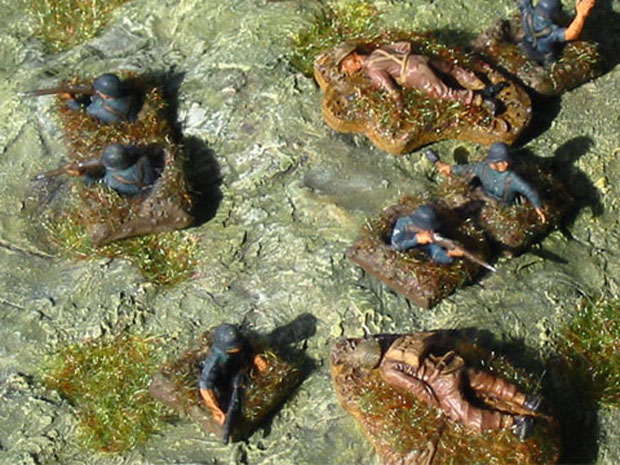Crossfire House Rules
Compatible with Crossfire Wargame Rules by Arty Conliffe

Status markers indicating "entrenched" and "suppressed" squads in a Crossfire game. We used the heads and upper bodies of standing riflemen to create infantry in foxholes. The casualty figures, too, are damaged or unattractive miniatures cut apart at the joints and reassembled in a relaxed or slightly contorted pose. Cover an irregularly shaped plywood base with household filler and texture it to resemble rough ground. Carefully press the figure parts into the wet filler and align them as desired. Large gaps may be filled with Rai-Ro modelling wax or putty prior to painting. To save time, expert modellers may want to make a silicon mould and cast many copies of a particular casualty figure.
Squad Status Markers
We use squad status markers which make it easier to differentiate between "surpressed" and "pinned". "NO FIRE" status is indicated with existing ammunition box status markers developed for the Fire and Fury ACW game System. Using the same "out of ammunition" or "no fire" status marker in two different games makes it much easier to remember the meaning of a particular marker. We also colour-code our status markers red, yellow, and green, to indicate the severity of a marker.
- Casualty Figure – red – Suppressed
- Prone Firing Figure – yellow – Pinned
- Crawling Figure – green – Ground-hugging
- Ammunition Box – NO FIRE
- Half Figure in Foxhole – Entrenched
Using prone firing, and crawling figures to indicate pinnend and ground-hugging status makes good economic sense, because it allows us to deploy all the superfluous prone figures we do not normally mount on our wargame figure stands.
Elite Units
Elite units are much better articulated than regular infantry, they fight in smaller tactical subunits and their individual members tend to take more initiative. To simulate better articulation we deploy elite infantry on half-squad or fire team stands.
Base Sizes
We use different base sizes to indicate the nominal troop strength of a tactical manœuvre elements. In close combat, the wider base receives a +1 bonus to account for its greater strength.
- Battalion Commander (3 Figs.) – 38 × 38 mm
- Company Commander (2 Figs.) – 38 × 38 mm
- Platoon Commander or Hero – 20 × 20 mm
- Sniper – 20 × 20 mm
- Infantry Section or Squad (4 Figs.) – 60 × 38 mm
- Infantry Group, Half-Squad, or Fire Team (3 Figs.) – 50 × 38 mm
- Infantry Support Weapon (2 or 3 Figs.) – 38 × 38 mm
A German infantry section of WW2 marched together, but fought in two groups: Schützentrupp (Schützen group) and l.MG-Trupp. In an attack, the LMG groups of the platoon would form an LMG firegoup under the platoon commander to provide covering fire for the rifle groups who attempted to flank and close with the enemy. If the rifle groups were ordered to attack, each section leader would be with his riflemen, and his assistant section leader remained with the LMG group. Accordingly, we split a regular German infantry section into two groups, each mounted on 50 × 40 mm bases. Lower quality German infantry may be mounted on regular 60 × 40 mm squad/section sized bases, although the 1st section of the platoon might be of better quality, again consisting of two groups.
If you would like to share your Crossfire House Rules with the readership of Military Miniatures Magazine, please write to klaus.schultheis@miniatures.de.